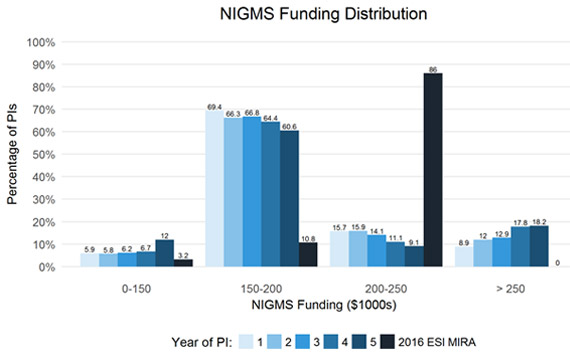One question that has been asked about the Maximizing Investigators’ Research Award (MIRA) for Early Stage Investigators is how awardees will be affected by the fact that they cannot have additional NIGMS research grants. In response to this question, we reviewed the research project grant (RPG) funding history of all 707 Principal Investigators (PIs) who received an NIGMS R01 as an Early Stage Investigator (ESI) between Fiscal Years 2009 and 2015. The PIs were grouped by Year of PI, which ranges from Year 1 to Year 5 (five years is the typical length of an ESI R01 award). Year 1 is the year in which the PI was awarded his or her initial R01, and Year 2-Year 5 represent the subsequent years. The awards and funding history of each PI were confined to Fiscal Years 2009-2015; thus, all PIs are included in the Year 1 group, while those who received their initial R01 in 2013, for example, would only appear in the Year 1-Year 3 groups.
The distribution of NIGMS awards (including subprojects) for these PIs is depicted below.
Adding up the percentages of PIs with two and three awards, Figure 1 shows that the percentage of PIs with more than one active NIGMS award ranges from 2.8% in Year 1 to 13.9% in Year 5.
The NIGMS funding distribution of these PIs is depicted below; it includes administrative supplements. Figure 2 also shows the 2016 ESI MIRA funding distribution for comparison.
Figure 2 shows that the percentage of PIs with more than $250,000 in NIGMS funding ranges from 8.9% in Year 1 to 18.2% in Year 5. Figure 2 also shows that 2016 ESI MIRA recipients (who all received $250,000 or less in NIGMS funding) had a much higher probability of receiving between $200,000 and $250,000 in NIGMS funding than non-MIRA PIs who received $250,000 or less in NIGMS funding.
Combining the data used to generate the previous two figures reveals that the percentage of PIs with both one or fewer active NIGMS awards and $250,000 or less in NIGMS funding ranges from 91.1% in Year 1 to 81.9% in Year 5. The data also show that 77% of the PIs had one or fewer active NIGMS awards and $250,000 or less in NIGMS funding in all years.
Taken together, the above data imply that the majority of NIGMS ESI awardees will not be negatively affected by the ESI MIRA requirement of having only one NIGMS grant for a maximum of $250,000 in direct costs per year. Furthermore, a majority of ESIs may actually benefit from the high probability of receiving between $200,000 and $250,000 in NIGMS funding as an ESI MIRA recipient (in fact, 50% of 2016 ESI MIRA recipients received the maximum amount). We also hope that ESIs will benefit from the enhanced research flexibility of the MIRA program, as well as the planned increase in funding stability. We will continue to monitor the progress of the ESI MIRA program carefully to ensure that it is meeting the program’s objectives and enhancing the efficiency and effectiveness of the biomedical research enterprise.




Your analysis only includes NIGMS funding. It would be interesting to know how many of these investigators got additional funding from other institutes or other sources (e.g American Cancer Society, American Heart Association, NSF) during this time. If a number did, that does provide an avenue for a very promising investigator to grow rapidly.
Overall I think the MIRA program has outstanding goals and implementation so far looks very positive. In particular having ESI investigators competing only with each other is a real advance.
Limiting a very promising young investigator to one grant during the first 6 years may ultimately penalize some people.
To me the biggest challenge appears to be: How will the “renewal” process work for MIRAs? The biggest “danger” time for people has been renewing that first RO1. I realize the MIRA program is supposed to “buffer” that challenge, and it will be interesting how the renewal process goes. People restricted to one grant during that time will certainly be in an “all or nothing” position at that renewal, which is something that would be good for the investigator to avoid if possible, and something we definitely encourage our faculty to try to avoid.